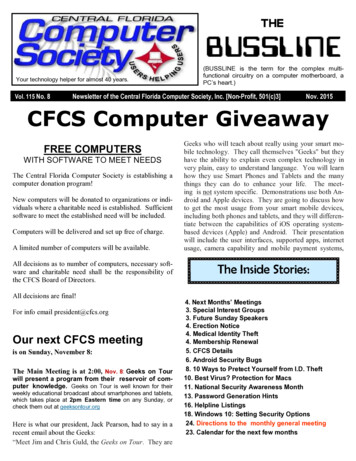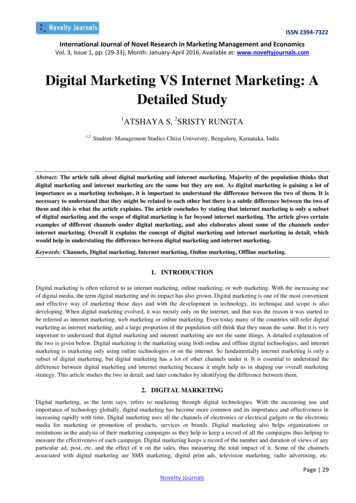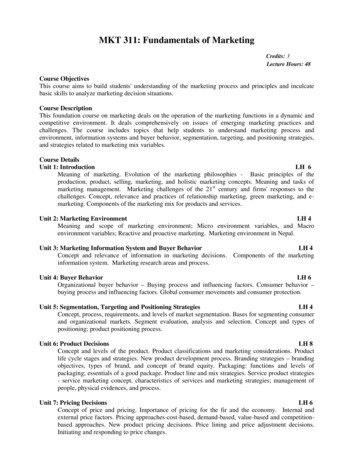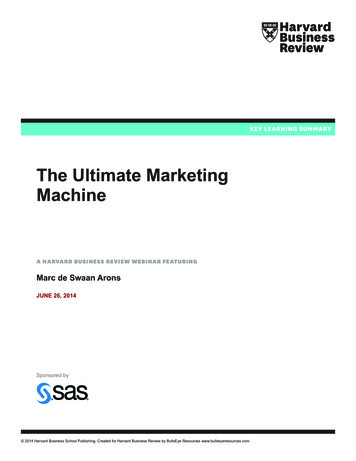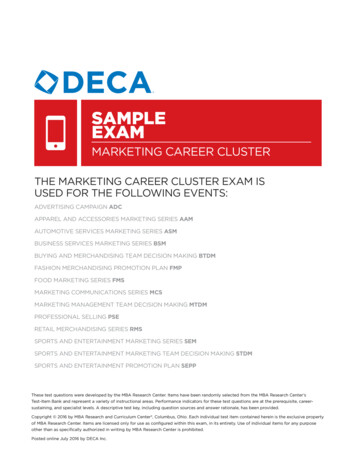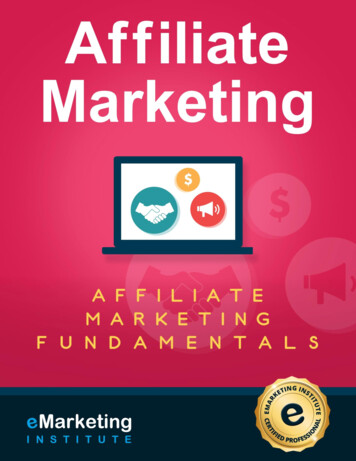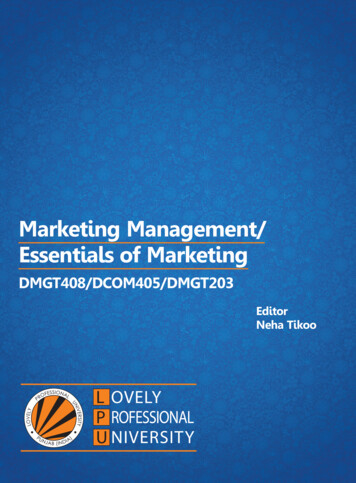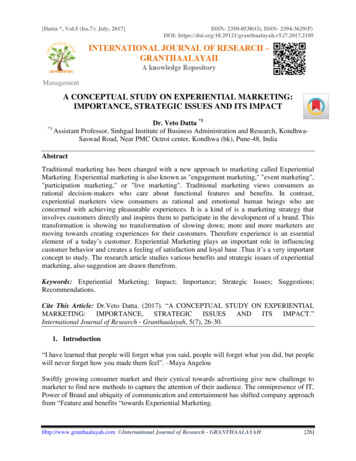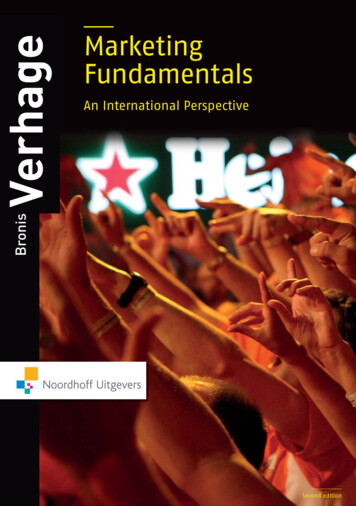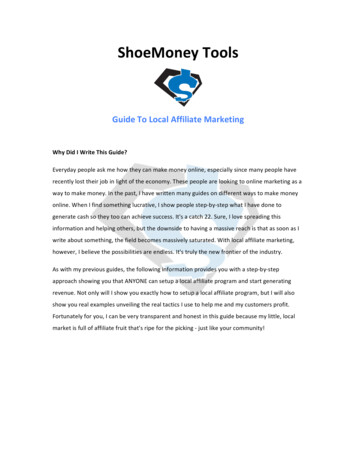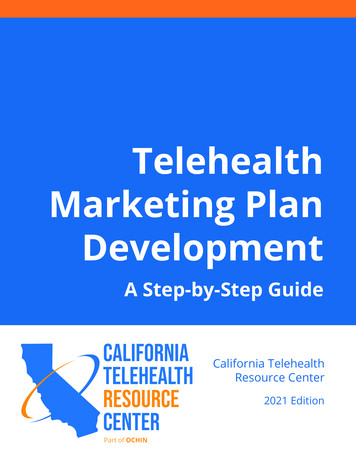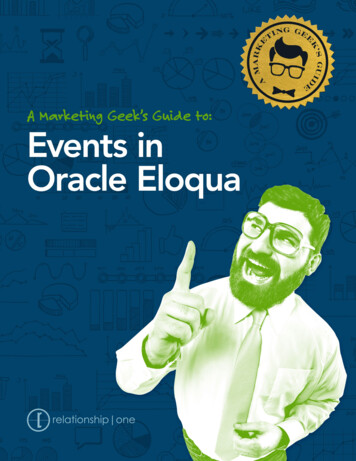
Transcription
A Marketing Geek’s Guide to:Events inOracle EloquaABOUT THIS SERIESOracle Eloqua has a plethora of different tools, some ofwhich you might not even be aware of. That’s where theseeBooks come in. We organized some of our top useful tooltips into this handy eBook for you to learn a lot in a quickread. Let’s dive in to see what our experts have to sayabout the Events Module.Oracle Eloqua is the most powerfulmarketing automation platform on themarket. It has the ability to scale to theneeds of the largest enterprises and theflexibility to solve just about anythingyou can throw at it.With all this power and functionality,sometimes complexity enters. That’swhere these eBooks come in. We tooksome of the areas of the applicationthat we get a lot of questions about andtried to unpack them in a way that makesthem simple to understand and easy toimplement. At Relationship One, ourmission is to “Inspire Success.” We hopethat reading through this eBook series willinspire you to try something new, solvea problem you’ve been dealing with,or invent something that will take yourmarketing efforts to the next level.Let our experts help you dive into anarea of Oracle Eloqua that you’re curiousabout and watch the inspiration flood in.Happy Eloqua-ing!RELATIONSHIP ONE8009 34th Avenue South Suite 300Minneapolis, MN 55425(763) 355-1025info@relationshipone.comA Marketing Geek’s Guide1
Chapter 1:Getting startedwith Oracle Eloqua’sEvents ModuleHave you ever wondered how you could streamline your events using marketing automation? Eloqua has a built-in eventmanagement tool that can help simplify and automate the downstream and communication process you use to promoteyour events. It’s called the Events Module. This tool can assist in managing both simple events and more complex ones.The best part? The Events Module is already part of your platform, and the process is completely replicable.FIRST, THE WHAT:The basic components of events include: invitation, registration page, confirmation, reminder, and post-eventfollow-up emails. With Eloqua, we let automation do exactly what its name promises automate the process. Byusing an Eloqua form, you have access to all the normal processing steps that you need to manage the contacts/leads in your system. When you add the Events Module functionality, you can send out customized confirmations,reminders, and follow-up emails to anyone who has registered by using the data that is collected on theirregistration form. This data is passed to the Events Module.Using the Event actions, you can control when and how someone receives the downstream communications.There are standard and advanced features in the event actions. Each step is customizable, and you can addadditional processing steps. You are also able to control if the event has a max capacity and you can automaticallydisable the services on a specified date.NEXT, THE WHY:Use field merges that pull in datafrom either the Event Session Fieldsor the Event Fields. The EventSession Fields contain the detailsabout a particular event session.They include things like Date, Time,and Location. The Event Field is thedata you collect on each registrationand aligns to the registration form. Itincludes things like First Name, LastName, and Email Address.You can take it one step further and use dynamic content to make your emails more customized.A Marketing Geek’s Guide2
CHAPTER 1 CONTINUEDFINALLY, THE HOW:For demo purposes, we’ll keep this pretty basic. You’ll need to create the following assets in Eloqua: Registration Form (include some sort of Session identifier if you are hosting a multi-session event) Emails (Invitation, Confirmation, Reminder, Thank You, and Sorry We Missed You) Events Module Field merges and dynamic contentNavigate to Orchestration Tools Events.Click on the Events drop-down and chooseNew Event Registration. Give your event aname and description and choose the folderyou want to save it to.Let’s walk through the setup of your Events Module. Click the Edit button beside each section to makemodifications to the details.1. Event OverviewYou can edit the name and description of your Events Module here.A Marketing Geek’s Guide3
CHAPTER 1 CONTINUED2. Registrant InfoThis contains the registration fields that are linked from the form. You can create additional fields, linkforms, and assign the Special Fields. There are two Special Fields: Email Address and Unique Identifier.Unique Identifier can be email address, an Eloqua ID, or one of your form fields. Use Email Address ifsomeone can only register one time per session.3. Event DetailsThis is where you set up the static details of the event for things like venue, date, time, location, speakers,etc. You can also choose if this is a one-session or a multi-session event. If you choose multi-session, youwill need to pick one of the Event Detail fields that it is organized by. As a standard setup, we suggestalways creating a field named Session and use that to organize events.4. Event ActionsThis is where the magic happens and where we enable Eloqua to do our downstream processes oncesomeone registers for our event. Through the Event Actions, you can set up your confirmation emails,control when someone receives a reminder email, send out notices to anyone who has been wait-listed,send out notices if the event has been cancelled, and send out the post-event communications.A Marketing Geek’s Guide4
CHAPTER 1 CONTINUEDThe processing is not limitedto sending emails alone.Here is a screenshot of theadditional options availableto help manage yourregistrations.The Event Actions hastwo tabs: Standard andAdvanced. Under theAdvanced tab, you canadd additional actionsto manage reminderand post-eventprocessing.A Marketing Geek’s Guide5
CHAPTER 1 CONTINUEDOnce you have all the actions configured, you will need to enable them by going back to the main view of the EventsModule and clicking Enable beside each action you want to activate. Eloqua system actions run every 15 minutes.That is the basic setup for using the Events Module. So, the next time you are tasked with managing an event,check out this hidden gem and give it a try.A Marketing Geek’s Guide6
Chapter 2:The Oracle EloquaEvents Module RocksAs consultants, we’ve executed many event-basedcampaigns for our customers. As marketers, wesupport the execution of at least one event campaigna month. To run this type of campaign, Eloqua usershave a couple options. You can facilitate the invitationprocess and post-registration communications throughthe traditional Campaign Canvas or leverage theEvents Module for execution (included in Standardtrim, add-on to Basic).FIRST, THE WHAT:The Events Module is a tool in the platform that’sdesigned to help you easily manage communicationsand actions that should happen once a contact hasregistered for an event. It’s a template interface that,within a handful of configuration decisions, managesthe experience for a registrant, including which emailsgo out to which registrants, when, and with whatcontent. There are a few other bonuses that I’ll touchon later, but that’s the main gist.The Events Module can manage the sending ofone version of a confirmation and one version of areminder email. By setting up each date/time optionas an individual session, any email that containsdetails about the session can be sent with fieldmerged data about that specific session, allowingyou to communicate the necessary details based onregistration selections using one email.In addition, the Event Actions in the Events Modulecan fire actions based on the date of the session.For example, if I’m offering a webinar on April 17and April 20, my one-day reminder emails will besent on April 16 to those registered for the April17 session and on April 19 to folks who registeredfor the April 20 session. Event Actions mirror formprocessing steps, which means you can do muchmore than send an email based on registrationinformation.CapacityMultiple SessionsAre you running a webinar campaign or facilitatingan onsite event with limited capacity? The EventsModule is set up to handle this. You can selectthe count of maximum registrations, and whenthat number is hit, automatically send a differentemail letting the registrant know that the limit hasbeen reached. Also, you will be notified that themaximum has been reached so you don’t have toconstantly check in on the number.If you’re running a webinar where you’re offeringregistrants several date options, you can save time andavoid creating multiple versions of confirmation andreminder emails. Or, if you’re really snazzy and you’reusing Dynamic Content to change out the content ofan email based on a session that a registrant selects,there may be a better option for you.One of the Advanced options is to have a Wait List.Once the capacity has been reached, registrantscan be put on a Wait List. If you offer a cancellationoption, anyone that cancels their registration getsbumped off the list and the next person the WaitList will be registered and sent the appropriateregistration emails.THEN, THE WHY & HOW:While the Campaign Canvas can handle events, thereare specific reasons why the Events Module may be thebetter choice.A Marketing Geek’s Guide7
CHAPTER 2 CONTINUEDModified or Incomplete RegistrationsIn addition to managing the experience of acancelled registrant, you can also easily set up aprocess to manage a contact that modifies theirregistration information or has not completed theirregistrant profile. For example, if someone registersfor the April 17 webinar, but later registers for theApril 19 webinar, the registrant can receive an emailthat acknowledges their information has changedand include the most recent details of their webinarselection.Automatically Disable ServicesIt’s happened to our clients and it’s happened to us.After the event has taken place, someone registersfor the event and they get all of the post-registrationemails all at once: confirmation, reminders, postevent, etc. This happens because most campaignsremain active for days, weeks, or months after thecampaign is complete. With the Events Module, youcan set a Disable Services date. This stops any EventActions from running after a specified date, ensuringthat irrelevant emails are not inadvertently sent.Organization for Ongoing NurturingWith the stellar event that you offered, you nowhave a list of registrants and attendees that haveraised their hand in interest. You can have these listsstored as Shared Lists or you can use the EventsModule to store all your event-based lists. Fromthere, you can leverage the ‘Has Linked Record inEvent’ filter criteria to add those specific contacts toyour Segments for further nurturing.You can do many more fancy things with the EventsModule, but those are some of the primary and mostuseful benefits that cover a majority of the use-casesyou’ll encounter.A Marketing Geek’s Guide8
Chapter 3:Oracle EloquaEvent Services Modulevs. Campaign CanvasFor many digital marketers, especially those of us who use Eloqua, automation is the name of the game. Maximumactivity with minimum investment of time. After all, “set it and forget it” options are what make Eloqua such apowerful tool.Remember when the Event Services Module (ESM) first peaked our interest? We could configure a series of actionsone time and just add new event sessions as they come along. Sounds too good to be true, right? Well, it isabsolutely true, but it’s not a one-size-fits-all solution.Like any other marketing strategy, events are unique to each organization, and the best approach depends on thebusiness process. Sometimes the hands-on nature of Eloqua’s Campaign Canvas is a better fit. Here are a few thingsto consider when deciding whether the ESM is right for you. Let’s compare the ESM and the Campaign Canvas:EVENT SERVICES MODULECAMPAIGN CANVASCONFIGURATIONEvent actions, similar to formprocessing steps or CustomData Object services, can beconfigured once, then runautomatically for all selectedevents.A new canvas must be built foreach event. Using a template willminimize the effort needed.EMAIL COMMUNICATIONSRe-use the same assets for eachevent session, merging in eventspecific data from event recordfields. The ESM assigns a uniqueID to each registration, ensuringthe correct session data isincluded in emails to registrants.By default, emails are used onlyonce. The team may decide tore-use assets, but will need tomerge in field data from CustomData Objects or Contact records,and select the email setting toallow for re-sending.FORMSFormsMore complex configurationis required to manage postregistration actions. This wouldrequire multiple forms and/ormultiple form-processing steps.A Marketing Geek’s Guide9
CHAPTER 3 CONTINUEDEVENT SERVICES MODULECAMPAIGN CANVASTIMINGThe timing for email notificationsand other event actions isautomatically set in relation tothe session’s date and time. Ifthe team needs to include postsession information in the followup emails, such as the URL fora recording, that data must bein place before the automatedaction is executed.Campaign actions are specificto each event, requiring manualconfiguration but offering morecustomization. The campaigncan be deactivated, or wait stepscan be used to hold campaignmembers until attendanceis collected and all of theinformation is ready for followup communications. This addsa degree of flexibility to theprocess.REGISTRANT RECORDSAttendees who did not initiallyregister through Eloqua mustbe added via upload or formsubmission.In an event with multiple sessions(or a parent event with manychild events), it’s possible for acontact to register more thanonce for a single session. This canresult in one contact receivingextra, potentially conflicting,communications.Attendees who did not initiallyregister through Eloqua can beadded to the campaign usingShared Lists, Custom Objectrecords or event vendor apps.A contact may exist in only oneplace in a given campaign,eliminating the risk of multipleregistrations and conflictingcommunications.For example, one record showsthe contact attended an event,the other record says he/she didnot. The ESM sees those recordsas two individuals.REPORTINGEvent record data can be sent toInsight, but there are no standardreports available in Insight.Reporting is found only via theESM interface.Insight has a variety of standardreports for campaigns runthrough the Campaign Canvas.VISIBILITY OF TOUCHESA history of event actions isavailable through the ESM, butemails sent from the EventsModule are not tracked on theContact record. This makestroubleshooting more difficult.Campaign membership andemail sends are visible on theContact record. If a contact isexcluded from an email, it’sindicated on the CampaignCanvas.A Marketing Geek’s Guide 10
CHAPTER 3 CONTINUEDEVENT SERVICES MODULECAMPAIGN CANVASSENDING TOEXCLUDED CONTACTEvents emails can be universallyallowed for unsubscribedcontacts and/or those on yourMaster Exclude list, ensuringtransactional emails, such asconfirmation and reminder, aresent.Sending to unsubscribed orexcluded contacts is defined inthe settings of each email sendstep.INTEGRATIONThe ESM doesn’t have a nativeintegration with external systemsor applications.Apps are available from thirdparty vendors to integrate theirsystems with Eloqua.A Marketing Geek’s Guide 11
WrappingThings UpAs you dive into the events module you will learn so muchabout how this powerful tool can help you plan and manageyour events. Our team loves to use this tool in our ownevent registrations along side Oracle Eloqua to keep all ourinvitations and emails in one spot. If you are using OracleEloqua for your marketing automation and have eventstoo, we strongly recommend you take advantage of thispowerful tool.You’re eager to get started practicing in the events module,aren’t you? Hopefully this eBook got you excited to improveyour event planning. Be prepared to learn as you go, andhave fun!If you have Oracle Eloqua and you need support with theevents module, we are here to help. Please visit our websiteat www.relationshipone.com to learn more about howwe can help! We love helping companies transform theirmarketing through strategy, technology and data.RELATIONSHIP ONE8009 34th Avenue South Suite 300Minneapolis, MN 55425(763) 355-1025info@relationshipone.comA Marketing Geek’s Guide 12
Eloqua has a built-in event management tool that can help simplify and automate the downstream and communication process you use to promote your events. It's called the Events Module. This tool can assist in managing both simple events and more complex ones. The best part? The Events Module is already part of your platform, and the process is .
